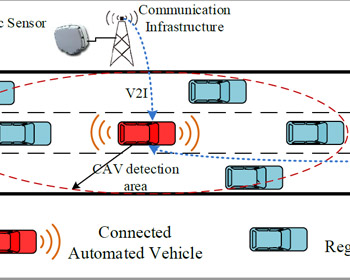

MPC |
| Title: | Impact of Connected Vehicle Technology on Traffic Safety under Different Highway Geometric Designs |
| Principal Investigators: | Xianfeng Yang |
| University: | University of Utah |
| Status: | Completed |
| Year: | 2019 |
| Grant #: | 69A3551747108 (FAST Act) |
| Project #: | MPC-590 |
| RH Display ID: | 154064 |
| Keywords: | connected vehicles, crash rates, crash severity, geometric design, headways, highway design, impacts, rear end crashes, traffic safety, traffic simulation, traffic speed, vehicle trajectories, width |
 With the recent rapid development of wireless communication and computing techniques, connected vehicle (CV) technology has reached a level of maturity and it can be expected that CVs will soon go beyond testbeds. Early deployments of CV technology have shown its great potential on improve highway safety performance. In this project, our research team aims to analyze the CV impacts on crash prevention under different highway geometric designs. Considering the strong correlations between highway geometric features and crash severity, this project will particularly study the impact of lane width, shoulder width, and alignment design on crash severity and provide guidance on methods that can be used in the impact evaluation. Grounded on a well-calibrated microscopic simulation model, this project will implement vehicle-to-vehicle (V2V) communication technologies to acquire real-time vehicle trajectory data. The collected information will further be used to analyze impacts of CVs on potential crash rate and severity with three types of surrogate measures of safety: standard deviation of speed, standard deviation of headway, and potential rear-end crash rate.
With the recent rapid development of wireless communication and computing techniques, connected vehicle (CV) technology has reached a level of maturity and it can be expected that CVs will soon go beyond testbeds. Early deployments of CV technology have shown its great potential on improve highway safety performance. In this project, our research team aims to analyze the CV impacts on crash prevention under different highway geometric designs. Considering the strong correlations between highway geometric features and crash severity, this project will particularly study the impact of lane width, shoulder width, and alignment design on crash severity and provide guidance on methods that can be used in the impact evaluation. Grounded on a well-calibrated microscopic simulation model, this project will implement vehicle-to-vehicle (V2V) communication technologies to acquire real-time vehicle trajectory data. The collected information will further be used to analyze impacts of CVs on potential crash rate and severity with three types of surrogate measures of safety: standard deviation of speed, standard deviation of headway, and potential rear-end crash rate.
Note to project PIs: please use the Track Changes feature when editing the above Word file(s). Updated document(s) should be emailed to ndsu.ugpti@ndsu.edu.